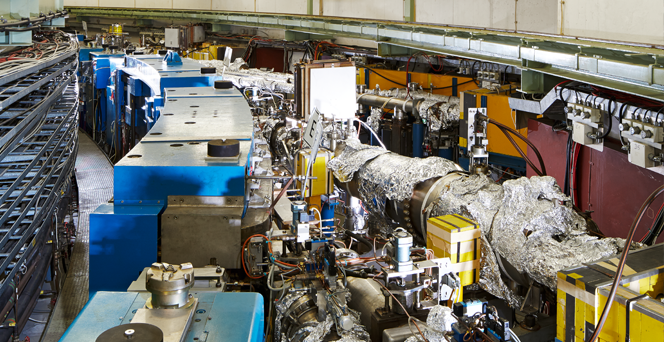URL: https://www.desy.de/e141261/e158573/e158613/index_eng.html
Breadcrumb Navigation

DORIS
Storage ring DORIS
The success story of DORIS began in 1974. Since then, it has generated a tremendous variety of scientific findings and applications. DESY switched off the storage ring in early 2013, but the “DORIS era” is still shaping current research. Generations of scientists have used DORIS to develop and test numerous experimental methods, innovations, and technologies that have subsequently been applied in science and industry all over the world. Very few major research facilities in the world can look back on such a long and successful career in the world of science.
In 1968, a decision was made at DESY to build the first storage ring in Germany – the nearly 300-metre-long "Double Ring Store" DORIS. This was a bold decision, because at that time storage rings were only available as small prototypes, the technology was new and barely tested. No one could say with certainty whether the new type of accelerator would deliver the desired results. But the boldness was rewarded. In nearly 40 years of operation, DORIS delivered important results for particle physics and became an extremely successful and powerful source of synchrotron radiation.
Start of a new era of particle physics
DORIS was designed as a storage ring for particle physics in which electrons collided with their antiparticles, the positrons. For 18 years, the accelerator provided a multitude of interesting results. The start-up of DORIS in 1974 occurred during a period of revolutionary change initiated by the surprising discovery of new quarks. DORIS made important contributions to this revolution in physics, for example the discovery of "excited charmonium states", which marked the birth of heavy-quark physics.
Later on, after the larger PETRA storage ring had been commissioned at DESY, DORIS proved that even a small facility can deliver big results. In 1987, physicists working on the ARGUS detector discovered that particles called B mesons can transform into their antiparticles, at a surprisingly high rate. From this observation, it could be deduced that the mass of the sixth quark, the top quark, which was still missing at the time, must be much higher than previously assumed. The top quark was eventually detected for the first time in 1995 at Fermilab in the USA.
The ARGUS detector was decommissioned in 1993. Many years later, its location at the DORIS storage ring was reoccupied by another particle physics experiment: in 2012, shortly before the shutdown of the storage ring, an international research team used the OLYMPUS detector at DORIS to study inconsistencies in the behaviour of the proton.
World-class research with synchrotron radiation
The applications of synchrotron radiation, which was originally a by-product of the accelerator’s operation, turned out to be equally impressive. From the very beginning, researchers at DORIS made use of the intense, collimated X-ray radiation generated by the accelerator for various experiments. Interest quickly grew. As a result, the Hamburg Synchrotron Radiation Laboratory HASYLAB was opened in 1981, and it soon became an internationally renowned facility. From 1993 on, the DORIS storage ring – following appropriate modifications – was operated solely as a dedicated synchrotron radiation source.
Some years saw more than 2000 experts from over 30 countries coming to Hamburg to run experiments at DORIS – physicists, chemists and materials scientists, as well as biologists, geoscientists and engineers from industry. Hundreds of postgraduate and postdoctoral researchers earned their initial spurs as scientists at DORIS. Countless scientific cooperations arose between multinational, and sometimes interdisciplinary, teams to carry out joint experiments in Hamburg. Experiments ranged from effective catalysts and precision analytical methods for determining pollutants to innovative active agents for medical applications and lightweight but stable new materials.
One of the most successful accelerators in the history of science
DORIS very impressively proves that when a major scientific facility is continuously adjusted to meet the requirements of science, it can be used sustainably over many decades. The people who constructed DORIS could not have begun to imagine the tremendous variety of cutting-edge results this particle accelerator would deliver in the course of time.
- Ring accelerator for electrons and positrons
- Length: 289 m
- Commissioning: 1974
- 1974-1992: particle physics and research with synchrotron radiation
- 1993-2012: dedicated synchrotron radiation source
- 36 measuring stations with 45 alternately operated instruments


